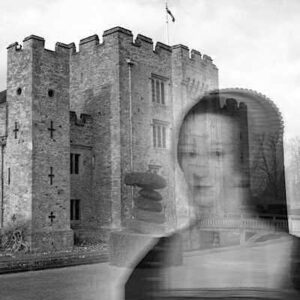 Thanks to Anne Boleyn Files visitor Nancy Smith for writing this great article on the ghost (or ghosts!) of Anne Boleyn – I love a good ghost story!
Thanks to Anne Boleyn Files visitor Nancy Smith for writing this great article on the ghost (or ghosts!) of Anne Boleyn – I love a good ghost story!
“With Her Head Tucked Underneath Her Arm and Other Tales of the Ghostly Anne Boleyn”
If legends are true, Anne Boleyn’s ghost must be the most traveled ghost in Britain – if not in the whole world! In researching Anne’s afterlife, I have found at least seven locations where her spirit is said to walk:
- Hever Castle, her childhood home
- Blickling Hall, her alleged birthplace
- The Tower of London, where she was executed
- Hampton Court Palace and Windsor Castle, where Anne and Henry resided during their marriage
- Salle Church in Norfolk, where Anne’s body was allegedly moved after her original burial in the Chapel of St Peter ad Vincula in the Tower of London and secretly buried under a black slab near the tombs of her Boleyn ancestors
- Marwell Hall in Hampshire, a residence of the Seymours between 1530-1638.
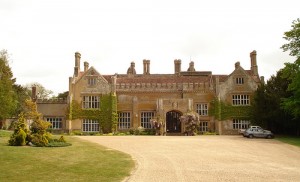
Marwell Hall - photo by davidhc on flickr Salle Church and Marwell Hall
I’ll start with the stories about which I could find the least information. I was unable to find any specific ghost stories relating to Salle Church, and the only story I could find about Marwell Hall is that she haunts YewTree Walk, where Henry VIII and Jane Seymour are rumored to have strolled while planning their wedding. Legend has it that Henry and Jane were at Marwell Hall while Anne was in the Tower awaiting execution, and that Henry had arranged for a chain of beacons to let him know that the execution had taken place. It has also been rumored that Henry first married Jane at Marwell Hall on May 19 (the day of Anne’s execution!) before their official wedding on May 30, 1536.
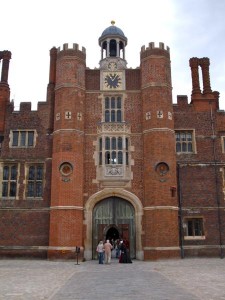
Hampton Court Palace - photo by Paudie Kennelly Hampton Court Palace and Windsor Castle
Anne also haunts two of the most famous royal residences in southern England – Hampton Court Palace and Windsor Castle. At Hampton Court she is seen wearing a blue dress. She has been described as walking slowly, with a sad countenance. One wonders if she ever encounters her successor, Jane Seymour, who died at Hampton Court on October 24, 1537, 12 days after giving birth to Prince Edward. Jane has been seen in the Clock Court and in the Silver Stick Gallery, wearing a white robe and holding a lit candle. Anne might also encounter the spectre of her first cousin, Henry’s fifth wife, Queen Katherine Howard, as she meanders the halls of Hampton Court. Following her arrest , Katherine allegedly broke free from her guards and ran towards the door of the Chapel, where Henry was at prayer, in hopes that if she could appeal to him in person, Henry would pardon her. Henry ignored her pleas, and Katherine was dragged struggling and screaming back to her rooms. The corridor through which she ran is now called the Haunted Gallery, and Katherine’s ghost can still be seen and heard running down the corridor, still pleading for mercy.
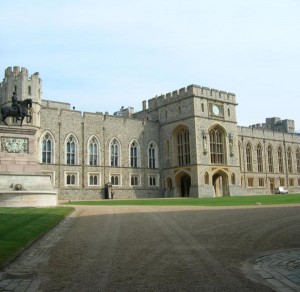
Windsor Castle At Windsor Castle, Anne’s ghost has been seen standing at a window in the Dean’s Cloister. If stories are true, the hauntings at Windsor Castle may be a (dysfunctional) family affair. Henry also allegedly haunts Windsor, and one wonders what they might say to each other if they were ever to meet. Castle guests have heard Henry’s footsteps echo along the corridors of the castle, and have heard him moaning and groaning as he attempts to pull his ulcerated leg along behind him. Henry’s and Anne’s daughter, Queen Elizabeth I, has been seen by several members of the royal family haunting the Royal Library. Sounds of her high heels are heard on the bare floorboards before her figure appears and passes through the library and into an inner room. She has also been seen standing at a window in the Dean’s Cloister, wearing a black dress with a black lace shaw draped over her shoulders. Since Anne has also been seen in the Dean’s Cloister, perhaps mother and daughter have been able to forge the relationship that they were denied in life in the afterlife. One certainly hopes so.
Now I’ll tell the stories that relate to the places that had the greatest effect on Anne during her lifetime, either because of the happy times she enjoyed there, or because of the traumatic associations she has with them.
Blickling Hall
To start at the beginning, Blickling Hall in Norfolk is the place where many modern historians believe to be Anne’s birthplace. The present building, built in the early 17th century, for Sir Henry Hobart, stands on the site of a previous building that belonged to Anne’s father, Sir Thomas Boleyn. On May 19, the anniversary of her death, Anne is said to return to Blickling Hall. A carriage comes up the drive leading to the hall, drawn by six headless horses and driven by a headless coachman. Anne sits inside, dressed in white and holding her severed head in her lap. When the carriage reaches the front doors, the horses and carriage disappear and Anne goes inside to roam the halls until daybreak.
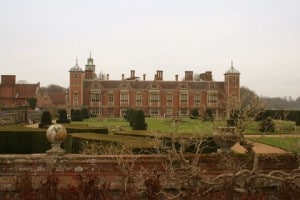
Blickling Hall Also on May 19 her brother, George Boleyn, Lord Rochford, is seen being dragged across the countryside by four headless horses. His headless ghost has also been seen wandering the grounds of the estate, searching for peace and justice. Blickling Hall is also said to be haunted by their father, Sir Thomas Boleyn. Some say he is the driver of the coach that delivers Anne to Blickling Hall on the anniversary of her execution. After dropping Anne off at the front doors at midnight, Sir Thomas continues on, pursued by hoards of screaming demons cursing him for his betrayal of his family. He is forced to drive his spectral coach over 12 bridges that lie between Wroxham and Blickling for 1,000 years as penance.
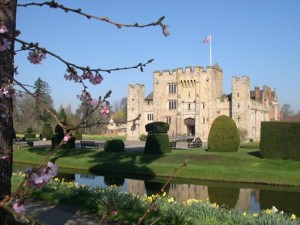
Hever Castle Hever Castle
Hever Castle, Anne’s childhood home, came to be in 1272, when Sir Stephen de Penchester was granted permission from Edward I to convert his house at Hever into a castle. The Boleyns purchased the castle in the early 16th century, rebuilding much of the castle and erecting a comfortable Tudor residence within its walls. Henry VIII was rumored to have courted Anne beneath the great oak, which is still standing. The hauntings at Hever Castle are not nearly as macabre as those at Blickling Hall. Anne loved Hever, so perhaps she returns there for peace, and to contemplate the happiness that she once knew there. Every Christmas Eve she has been seen crossing the bridge over the River Eden in the castle grounds. She has also been seen standing beneath the great oak, under which Henry wooed her.
The Tower of London
The final, and by far most active of the places that Anne allegedly haunts is the Tower of London, the place of her execution. If ghosts are, as some believe, surviving emotional memories typical of one who has died violently, traumatically and tragically, as Anne did, then it is very understandable that some essence of her remains at the Tower. The main fortress of the Tower, known as the White Tower, was begun by William the Conqueror in 1078 and added onto by subsequent monarchs, so the Tower was already over 450 years old when Anne became queen. Since the Tower was a place of imprisonment and death for most of its existence, as well as a royal residence, it is said to be the most haunted building in London, if not the whole of England.
Anne Boleyn’s ghost has been seen in several places around the Tower grounds – in the White Tower, the Queen’s House, where she allegedly stayed the night before he coronation and also during her imprisonment prior to her execution (Claire’s excellent article about Anne and the Tower proves that this is a fallacy – see Anne Boleyn and the Tower of London); Tower Green, site of the scaffold; and the Chapel of St. Peter ad Vincula, where she was buried under the floor of the chancel in an arrow case.
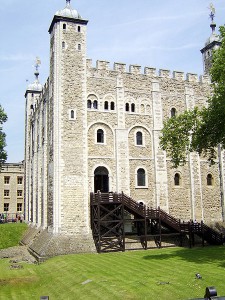
The White Tower In 1817 a sentry patrolling the White Tower suffered a fatal heart attack after encountering a ghostly Anne Boleyn on a staircase. In 1864 a sentry standing guard outside of the Queen’s House reported seeing the white figure of a woman veiled in mist. She was wearing Tudor dress and a French hood; however, where her face should have been there was nothing. He challenged the figure and when it did not reply and continued towards him, the sentry made a thrust at it with his bayonet. What happened next caused him to swoon – his bayonet passed through the figure, and a firey flash ran up his rifle and gave him a shock. The sentry was court-martialed for falling asleep during his watch. He was found not guilty when several eyewitnesses told the court that they had also seen the headless woman on Tower Green that night. One officer who saw the event from a window in the Bloody Tower testified that he had heard the sentry yelling at the figure to stop, and then saw him thrusting his bayonet through it. He saw the figure pass through the bayonet and then through the sentry as well.
By far the most spectacular haunting by Anne in the Tower takes place in the Chapel Royal of St Peter ad Vincula, where she is buried. In the late 19th century, a Captain of the Guard noticed a light burning in the locked chapel late at night. Upon finding a ladder and placing it against one of the chapel windows, he was shocked at the scene taking place in the otherwise “empty” chapel. It can best be described by an excerpt from Ghostly Visitors by “Spectre Stricken”, London 1882:
“Slowly down the aisle moved a stately procession of Knights and Ladies, attired in ancient costumes; and in front walked an elegant female whose face was averted from him, but whose figure greatly resembled the one he had seen in reputed portraits of Anne Boleyn. After having repeatedly paced the chapel, the entire procession together with the light disappeared.”
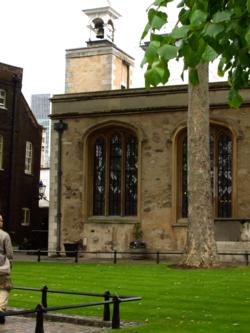
Chapel of St Peter ad Vincula - Photo by Paudie Kennelly by Nancy Smith
Thanks for a wonderful article, Nancy!
With Her Head Tucked Underneath Her Arm
Nancy’s article title “With Her Head Tucked Underneath Her Arm” refers to a song about Anne Boleyn’s ghost, written by R P Weston and Bert Lee in 1934 and performed by Stanley Holloway. Here are the lyrics:-
In the Tower of London, large as life,
The ghost of Ann Boleyn walks, they declare.
Poor Ann Boleyn was once King Henry’s wife –
Until he made the headsman bob her hair!
Ah yes! he did her wrong long years ago
And she comes up at night to tell him so.
[With her head tucked underneath her arm
She walks the Bloody Tower!
With her head tucked underneath her arm
At the midnight hour…]
She comes to haunt King Henry,
She means giving him what for,
Gadzooks, she’s going to tell him off for having spilt her gore,
And just in case the headsman wants to give her an encore
She has her head tucked underneath her arm!
[Chorus]
Along the draughty corridors for miles and miles she goes,
She often catches cold, poor thing, it’s cold there when it blows,
And it’s awfully awkward for the Queen to have to blow her nose
With her head tucked underneath her arm!
Sometimes gay King Henry gives a spread
For all his gals and pals – a ghostly crew.
The headsman carves the joint and cuts the bread,
Then in comes Ann Boleyn to queer the do;
She holds her head up with a wild ‘Wahoop!”,
And Henry cries ‘Don’t drop it in the soup!’
[Chorus]
The sentries think that it’s a football that she carries in,
And when they’ve had a few they shout ‘Is Ars’nal going to win?’
They think it’s Alec James, instead of poor old Ann Boleyn
With her head tucked underneath her arm!
[Chorus]
One night she caught King Henry, he was in the canteen bar,
Said he ‘Are you Jane Seymour, Ann Boleyn or Cath’rine Parr?
For how the sweet san fairy ann do I know who you are
With your head tucked underneath your arm!’
(Source: Wikipedia)
Videos
In the following video on ghost stories from the Tower of London there are some great clips of the Tower of London but Anne was never imprisoned in the Queen’s House (built in the 1540s) and there is no evidence that she had 6 fingers and 6 toes or that she was ” a peculiar woman”! This is what we’re up against!!
And here’s one of the Hampton Court Palace ghosts:-
What do you think?
Sources for Nancy’s Article
Wikipedia – Anne Boleyn
The Shadowlands: Famous Hauntings – The Haunting of Hampton Court Palace
Windsor Castle – Ghost Stories, Ghost Sightings and Haunted History
Quest for Ghosts – Blickling Hall, Blickling, Norfolk
Ghost Story – The Ghost of Anne Boleyn
Information Britain – Blickling’s Boleyn Bedevilment
The Culpepper Family History Site – Hever, Kent – Hever Castle’s “Haunted House Story”
The Red Pill – Ghost of Anne Boleyn
Mysterious Britain & Ireland – The Tower of London
Paranormal – The Traveling Ghost of the Headless Witch: Anne Boleyn by Patrick Bernauw, published 2/17/09
Camelot International – The Tower of London – The Ghost of Anne Boleyn
Tower Ghosts – Tower of London – Icons of England
Hampshire Legends, Ghosts and Apparitions
Well! If after watching the narrator Miss Bristol, we are all supposed to Think that lovely Anne Boleyn was peculier, than I`m living on the wrong planet!!! Thankyou!
I can imagine what the meeting would have been like at Windsor Castle between Anne Boleyn and Henry VIIII as ghosts with each one saying to the other “YOU DID THIS TO ME”. Talk about the laws of karma. Him with his ulcerated leg and her with her head tucked under her arm. Now that I would pay to see on “The Tudors”.
Lovely article. Thanks. I don’t actually believe in ghosts, but I love a good ghost story. If anyone could find a way to haunt someone, I think it would be Anne.
Okay so the ghost video at the end-I think I believe it. Or maybe I want to believe it. But it would definitely help if they would show the other videos all at the same time to prove that it was real. The question is was it Anne?
The first video made me a little upset, that woman has no idea what she’s talking about and she kept trying to make things seem so much scarier than they were with the tone in her voice and her “peculiar” eyes.
I agree with you Belle – I do think I believe that video. Anne peculiar – I do not think so.
Maybe in the sense that she was more outspoken than the average woman was for her
time period and I have heard that she had six fingers on one hand, however Claire has said there is no evidence to that. I have often heard that she does haunt the Tower and she had such a sad death I would be able to see why. ( I only believe the first video)
I would like to thank you for all this knowledge. I had often wondered what had happened to the spirits ( ghosts) of all.
It really does widen my scope of a disaster that should never have happened to a King and Queen. Karma ? I wonder !
Renee Woolsey Smeaton-Burgess USA
Belle, I absolutely agree with you about the first video–the woman also stated unequivocally that Anne had six fingers and six toes–there has yet to be proof of that.
Also, the narrator’s script wasn’t historically correct either in stating that Henry had Anne executed because the Catholic church wouldn’t allow divorce–at that point, his concern wasn’t the Catholic church but his peers and populace.
The second video is compelling. I wish I could play it on my Tivo and thus might be able to debunk it. I thought of Elizabeth I when I saw it. I recommend submitting the video to a debunking site to see if they can do anything with it.
Cynthia I agree with you that it seemed more like a womans figure than a man. I do not think it is Henry VIII – I am more of the opinion of you that it is Elizabeth.
Well.. at least it is a fun topic to talk about, although much of it is hogwash. (That last video certainly is.) The most interesting one is the sentry with the bayonet in 1864. Was it a buddy looking our for buddy when they were reprimanding him for falling asleep?
Six fingers and now, six toes? Where did this woman get her info? She was rather peculiar herself.
Love the second video. It should be sent to Ghosthunters International to see if it can be debunked. Or not.
Great article.
Well, here’s one thing to consider about the second video: if the “ghost” could open the doors without touching them, why couldn’t it close the doors without pulling them in? My guess would be electric alarm activated doors opening, perhaps in response to a fire alarm going off, and an employee dressed in a period costume knowing it was a false alarm and closing the doors.
I’m glad that people are enjoying the article and think that it’s a fun article for a change. I wrote it for people to enjoy. I love a good ghost story, too, even if I’m not exactly sure whether or not I believe. I’ve certainly never seen a ghost. I went to the psychic event at Hever Castle in October, but Anne didn’t see fit to appear (although a bat was flying around King Henry’s room – that was the scariest thing that happened). I really wish she would have – I would have loved to have met her. And, as Cynthia said, if anyone has a reason to haunt it is Anne!
I agree with Cynthia. Electrical failures can happen any time and it does look like an employee dressed in costume closing the doors.
In her book on Anne Boleyn, Norah Lofts described how she had visited Salle church and been shown the stone slab by a churchwarden who told her that he’d once sat up all night in the church on 19th May to see whether the ghost of Anne appeared. He saw no ghost but he was disturbed by a large hare, which appeared fron nowhere and led him through a wild chase until he stubbed his toe on a pew, when it disappeared as myseriously as it had appeared.
Ms Lofts was delighted that the man had no idea that a hare was one of the shapes supposed to be assumed at will by witches and like the idea that Anne might have returned in this elegant and elusive form to tease him.
In the video where it shows the “ghost” shutting the doors, it actually looks like the dress and hair style of the “ghost” is more of the Elizabeathan era rather than the Tudor era.
Just wondering if anyone thought that as well?
I live just up the road from Marwell House, which is inside the grounds of Marwell Wildlife Park, Hampshire. I’d love to go in there with a dowsing pendulum and find Anne, Henry and Janes’ ghosts. Also I’d love to take it to Windsor.
I have to admit, ghosts scare the dickens out of me while at the same time, fascinate me! I would love to go on a ghost hunt for Anne! I believe in ghosts and have been in the Tower of London and, while I didn’t see any ghosts there, I could feel the presence of the people tortured and killed violently there. It’s hard to explain but it’s like a residual energy. Thanks for the ghost stories!
Christine, I agree with you on that short video. The ghost looked more like Elizabeth to me!
I remember seeing that second movie with the doors on the news, aparently they don’t have costumes like it on site. Still, makes you wonder!
http://www.thesun.co.uk/sol/homepage/news/article79096.ece
Oh, I still wonder if any psychics have visited these places to see if they can sense Anne’s presence. I do think that places where extreme emotion or duress is experienced are likely to be haunted, much like the camera can record one moment. Who knows?
Hello! I’ve just watched the two videos posted above. As Cynthia pointed out with the first one, Anne Boleyn was reputed to have a so-called “sixth finger”, which was actually more of a very tiny second nail on the side of one of her fingers. But Elizabeth Bristol claims that one of Anne’s feet had six toes? I never saw that in the accounts I read of Anne’s appearance, so I too wonder where Ms. Bristol got her information. I also agree with Cynthia in that Henry VIII didn’t execute Anne Boleyn because the Catholic Church wouldn’t allow him to divorce her. He had her executed on trumped-up charges of witchcraft, adultery, and incest because she couldn’t give him the son he so desperately wanted, and he felt Jane Seymour could. And there was a huge history blunder regarding Anne Askew. She was not put to death because she was accused of witchcraft; she was tortured and then burned at the stake for preaching the “new religion” that would later be known as Protestantism.
As for the second video of the mystery figure closing the fire doors, I once again agree with Cynthia. That wasn’t a ghost closing the doors, but a very real flesh-and-blood person in a costume. The incident was later dismissed as a hoax.
Oh, and I forgot to mention something else. In an era where it was demanded of a wife to be docile and obedient to her husband, Henry grew to hate Anne’s temper tantrums and outspokeness, which only worsened when Anne learned of Henry’s affair with Jane Seymour.
Henry had more temper tantrums than a whole room of 4 year olds going to pre-school. How come Anne is mentioned as having a temper but she may have had good reason to be angry with Henry. She may have been not been as docile as she was suppose to be, but Henry was hardly as polite as he could have been.
Because quite simply, he was King and very pampered and spoiled, back then men did what they liked and women had to like it or lump it frankly. Anne may have been Queen but Henry was King and there is nothing higher than a king when it is his birth right to be on the throne, (same as when a Queen is regent by birth right her husband must be known as a prince) Put simply Henry didn’t have to be polite, he was King. As for the video am i mistaken or is that an Elizabethan ruff around the neck?
Are ghosts real? Who knows. I remember reading about an experiment conducted years ago at a university medical school; I can not remember which one unfortunately but the results were very interesting – and very creepy. Volunteers with terminal medical conditions agreed to end their days at the university hospital, hooked up to every modern medical recording device then known, and laying on a bed on a weight scale. The researchers recorded the combined weight of the person, bed, and any other equipment resting on the scale prior to death and immediately after death. It was found that several pounds were missing after death that could not be accounted for by the expulsion of oxygen in the lungs. We do not have that amount of oxygen or gas in our bodies at any time. I believe it was in excess of 4 or 5 lbs. Any exrecetions at the time of death would have been accounted for as the body was weighted within minutes of death so there was no time for anything to be removed, evaporated, or anything else that might account for less weight. Was the missing pounds a soul? Did the spirit of the people leave the body at death, causing it to weight less? The researchers could never find a reasonable explanantion for the missing weight.
Personally, I believe our spirits can wander for a time whether because of a violent, tragic, or untimely death or because life had been so good they do not want to leave. My ex-husband and I rented an old farm house in Washington State for less than a year in the late 70’s. The next door neighbor had known the original owners; they had raised their children together. Miss Sophie was then in her 80’s, and as clear headed as a teenager. One night as I lay on my stomach in bed, next to my husband, reading Stephen Kings’ “Pet Semetary” and being completely awake, I felt someone off to the side. I thought at first it was one of the children but no one was there and I went back to my reading. I was awake; I can not emphasize that enough. I was completely involved in the story and was determined to finish the book that night, no matter I had to rise early to get the kids off to school and go to work. My husband snored beside me; my cat was curled at my feet. Suddently my cat ran out of the room. No stretching or yawning as a cat does when waking; just a sudden mad dash to get out. I softly laughed thinking to myself she must have picked up on the creepy feelings the story was generating in me. Then I felt my blankets, tucked around me at my waist leaving my upper back and shoulders exposed, lift off me. I felt them creep up to my shoulders. Hands gently tucked them around my shoulders. The bedside reading light flashed out and I was so scared I was frozen in place, unable to even breathe. When I regained myself somewhat, I tried to turn on the light – but the light was in the on position. The next day, my husband unplugged the light and replugged it in the socket and it worked fine. A few days later I told Miss Sophie of the experience. She told me that I had met the mother of the house; she and her husband had built the house and raised a large family there, doing a little farming and raising pigs in the 20’s, 30’s, and 40’s before she passed away in the early 50’s. She had often come back to visit her family before the husband died and the children sold the farm, breaking it into lots for houses to be built. Miss Sphoie told me that her children and theirs had often spent the nights with one another and both she and the original lady of my house always “made the rounds of children”. They would go from bed to bed, covering children with blankets, and turning out the lights. She went to say I had probably been “tucked into bed” by a woman who loved being a wife and mother and whose idea of heaven would be to continue to nurture and love a family.
From then to now – I beliieve.
Back in the sixties as we were driving past Rochford Church and graveyard, my father told me that Anne Boleyn haunted it, head under arm and all! She had been seen many times he said
I just found this article and I too love a good ghost story.
I had a question that has been bothering me. During Queen Victoria’s rule, the bodies of Anne and Katherine Howard were given more fitting burials in the Chapel. When Anne’s body was exhumed, did they notice or report seeing a sixth finger bone? I would have thought they would have mentioned it. Does anyone know?
Hi Peggy,
I have the 1876 report of the work undertaken on the Chapel of St Peter ad Vincula, along with the reports by Dr Mouat who examined the remains, and even though the Yeoman Warders often thrill crowds of tourists by saying that they found a 6th finger they certainly did not. See https://www.theanneboleynfiles.com/anne-boleyns-remains-the-exhumation-of-anne-boleyn/6426/ for further details.
What a laugh, if Anne is meant to be perculiar, how on earth would you decribe Ms. Bristol, she’s as mad as a box of frogs… weird lady. She certainly would be an ideal person to take you on a ghost hunt, I think she would give you the heebie-jeebies more than any ghost 🙂
Thanks – Enjoyed this blog post, can you make it so I receive an alert email every time you publish a fresh article?
You have a wonder site.
I think the first video Ms. Bristol is a silly woman who needs a good history book to read. It is sad when history is confused with myths.
The second video although fun to watch I am not so sure it’s a ghost. I do believe in ghosts having grown up in Great Britain.
Thank you for sharing your knowledge of Tudor history.
After going to the Tower of London, I returned to Costa Rica. With a full suitcase, I was once searching some information about where exactly the ghost of Anne Boleyn had been seen. Having a look at all of the possibilities, I was pretty interested on Tower Green, which I didn’t really remember. So, I wanted to look for a brochure I got in the Tower of London but it was in my suitcase, so I was too lazy to get it. Then, I went to my bedroom, and when I was back to the living room, I saw on the floor a large quantity of papers that I had there and over all of that, there was the brochure I wanted to have a look at.
Oh my God, that second video… That appearing woman’s figure totally looks like Elizabeth I. Just…CHILLS!
I have always been scared of ghosts and anything scary so honestly I’m a little scared to watch the second video just because of the image that it’s showing right away. However based off of what you guys have been saying I may just change my mind. I don’t know… do you think it was a scary video?
I Believe In Anne Boleyn`s Ghost Because Once Before Bed When I was eight My Mum Told Me A story of when she was in school. She told me ” Once I Went to Hampton court When I was in school. It was for a school Trip. I slept over at Hampton Court and I saw a Ghost. ” She said ” It was dressed in med-evil Clothes. Like Henry VIII. She was opening and closing doors!!” She Added. That Night I slept with all the lights on, With all the doors open,My window closed and and me in the middle of all my toys. I was so Scared That Night. I Am Ten And I am soon going to face my fear and go to Hampton Court With My Dad!!
Also Anne Boleyn had 11 fingers (included Thumbs) and 11 toes!! Wierd Because One Of My Friends Has Exactly The Same!! she had 11 fingers and 11 toes!!
Emily, that isn’t true. Anne Boleyn had NO extra fingers or toes. In Anne Boleyn’s time, people thought that having an extra finger or something like that, was a sign of being a witch. Because they wanted everyone to hate Anne and think she was a bad person, they made things up about her and people today think those things were true. In Queen Victoria’s time, Anne Boleyn’s grave was opened and her skeleton was examined. She was found to be about five feet three inches tall and her hands and feet were completely normal.
Elizabeth Bristol needs to get her facts straight and to present her material in a straightforward manner.
Nice collection of stories, interesting places, but sorry, no such things as ghosts and no evidence has ever been shown to be authentic. Most have either been put down to imagination or simple explanations. The Hampton Court ghost turned out to be a prank and they do not refer to it as the Haunted Gallery anymore on visits there. In fact they have not done so for several years now. In the three visits I made in 2009 and all the many books and guidebooks and exerts I have asked it is called the Long Gallery because this is what it is.
I’ve seen ghosts. Sorry.
So have I. Four very authentic, supernatural experiences. Naturally, I cannot produce evidence that would convince non-believers, but, never mind: I saw what I saw, heard what I saw, and it was quite sufficient. I understand the afterlife no better than any of the rest of us still in this life; but, it is there.
The imagination is a powerful thing. Ghosts bring in the tourists.
Well, regarding the second video (sorry if you already said that, I didn’t read all the comments) it was finally discovered that was a member of the staff closing one of the doors that are used for them – and not the public –
Some staff dress as the king Henry or the wives or Mary I and Elizabeth I and make performances at Hampton Court, so ladies, sorry, no ghost this time (thank God, because I’m really scared of them, cannot say they exist, but cannot deny it neither!)
The Hampton Court Palace ghost has been debunked as a hoax, very good job though! I believe Anne did not have 6 fingers and toes, how ridiculous! In a time where you were burned at the stake for being a witch, and deformity was “proof” of that, I’m sure the family would not have let her live. And do you think Henry would marry someone who was deformed?? I don’t think so…
The only ghost of Anne’s that I can truly believe would be at The Tower. There are different types of hauntings, from residual to intelligent, poltergeist, shadow people and demonic (they’re not spirits though). Hers was such a violent death that even if she’d made her peace with God, she would still dwell in her last resting place and be more of an Intelligent haunting. She was certainly vivacious and intelligent in life!!!!
If you were found guilty of witchcraft you were hung in England but burnt in Scotland, when I saw the video the face was that of a skull obviously a mask, it just didn’t look real.
I’m American and have had the privilege of visiting the Tower of London twice in my life! I love Tudor history!! Anne Boelyn is one of my favorites!! We had plans to visit Hampton Court Palace before we left England, but those plans fell through 🙁 I do hope, however we are able at some point in the future to return and do some more touring!! I love the tragic history, so sad and yet so BOLD with Elizabeth I–what woman doesn’t love her spirit!!! Thank you for the information! I look forward to reading more!!
The Tower is a wonderful place to visit, isn’t it? What a shame that you missed Hampton Court Palace, but that does give you a great excuse to go back to England!
When I visited the tower of London, I found myself alone in some of the rooms and felt scared to be there by myself! So many people had lived and died there! It was an awesome place to visit however, and a lifelong dream to go. I love knowing you have walked where people you’ve done so much research and reading on, have walked.
The Tower is an amazing place. I always feel very moved looking at the wall carvings in the stone of the Beauchamp Tower, it makes the history so real.
One thing is clear. Ann was not a very nice person . If you carefully read what is really known and happened she pushed the King in a bad direction that turned him into a haunted man. He got traped because he longed for her and a son . In that time and age it is clear he went nuts. She turned his life and what he believed in up side down and that for nothing. She also was hateful to Cathrin of Aragon and Mary her daughter. If a woman in our days would do this she would be also called a wh*re and worse. Ann`s bad name is of her own doing. She payed the prize and lost her head. Many people lost their life because of her only because they would not exept her because of Cathrin of Aragon, because they stayed firm to what they believed right. So Cathrin treated evil is ok in your eyes but Ann treated the same way is not ok? I often see this fanatic in people because they have no input and are not able to understand how people in that age where ticking. Even that noone would like a cheater in our days unless he is so himself seems to be completely forgotten. Everyone that only sees her as a victime should ask herself. If your husband would do to you what Henry did to Cathrin of Aragon would you ” love ” Ann for taking him away from you? Would you still think she was a saint and did not got what she asked for?
Catalina was no saint, herself.
And nor was Henry VIII.
Why lay all blame on AB?
Anne Boleyn I agree was not the best tempered person in the world and harsh punishments were given to people who spoke against her marriage to Henry but Anne did not make that legislation, Henry and Cromwell laid it out and Parliament passed it. Anne was not responsible for the death of Thomas More and John Fisher, Henry was. Henry was unfair to Katherine but he decided to annul his marriage before he fell in love with Anne Boleyn. He may have been persuaded to move forward with the divorce, and I agree that his decision was problematic but Henry believed his marriage to Katherine was invalid and needed a son, but Henry asked Wolsey to look into this point before his affair with Anne Boleyn. Regardless of the unfair treatment of Katherine and Mary, however, which we have to condemn as both the fault of Anne and Henry, Anne was still, at the end of the day, an innocent victim as she was tried and executed on trumped up charges for which she was innocent. Anne Boleyn is controversial for many reasons but she was very interesting as well. She has more to commend her as Queen than she is given credit for. I am a big supporter of Katherine of Aragon but the evidence shows that Anne was not the nasty witch of Hollywood. She was not a saint or total victim of Henry Viii and his pursuit of her, nor was she a pawn. Anne was generous and whitty, she was interested in reform, but she had a social conscience, she was interested in promoting good works and community projects, she was intellectual, she was able to understand the inns and outs of the theological arguments over the annulment, she had a temper and had her nasty side, but so do we all, humans tend to lash out under stress, she could be unguarded with her tongue and did not always think before speaking, to her cost, but she could also be very perceptive. Yes she did have a part in the bullying of Mary, but Henry was behind this after her death and Anne did try with Mary. She was a fantastic dancer, she was talented and attractive in many ways, she was musical, a patron and she was modest and strict with her household. She could be forceful and did get on Henry’s nerves with her jealousy and complaints but they were also well matched and merry together. Anne Boleyn did not force Henry to banish Katherine although she did nothing to intercede for her or Mary but moaned about them while under stress. Anne also suffered two losses of children, the loss of a son left her vulnerable to the attacks of her enemies. While you cannot justify her affair with Henry per say, Henry Viii is as much to blame as he approached her and persisted until she agreed to be his companion but Anne would not be his mistress. The couple fell in love and their decisions about marriage and the divorce were joint ones. You cannot blame Anne for the divorce or the legislation that led to needless executions, without blaming the primary mover, the person with the power, Henry Viii.
I love the idea of Elizabeth and Anne’s ghosts being united in the end. Hope this to be true. At least she’d have some form of a happy ending from it
Si relmente existen los fantasmas(yo creo que si)mas reales se hacen si tienen una muerte violenta e injusta como la de Ana,seguramente le habra hecho pagar bien caro la maldad y lujuria a HenryVIII ,lo va a seguir eternamente!!!!!
Wham bam thank you, ma’am, my qunoitses are answered!
Henry VIII was playing tennis when Anne Boleyn was beheaded. Not strolling throught the gardens with Jane.
Henry VIII was playing tennis when Anne Boleyn was beheaded. Not strolling through the gardens with Jane.
I believe he was actually out hunting, he wanted to be as far as away as possible from the crime scene so to speak. A warning gun was fired to let him know the job was done and that he was free to be betrothed to Jane. He married Jane just 10 days after Anne’s murder.
I enjoyed reading this and it confirms my conclusion that hauntings are often connected to tourists and their cash.
We are but spirits housed in flesh. My spirit left my body as a 12 year old child I woke on the ceiling of my bed room .I looked at my hands and knew something was wrong.Only when I looked down on the form of body in the bed did I see myself and panic set on I was back inside the body concerned but calm. It happened in a hotel bar aged 45 when suddenly I felt faint and walked to the toilet looked back to my body at the bar motionless and walked trough the door into the wash room. For some time I saw no reflection in the mirror. I rushed back as a man was trying to revive my body and so came alive. He said that my body looked dead. He advised a doctor I should see. So yes the spirit is the ghost but just how that works I have no idea.